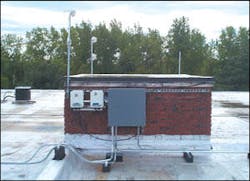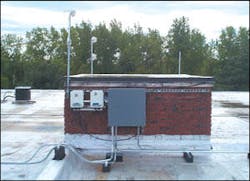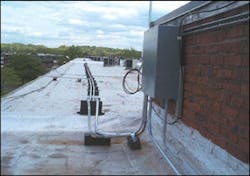Blocking surface abuse in a rooftop Cat5/wireless project
Cable company finds alternative to harmful wood blocks for wireless Internet access installation.
Commercial, industrial, and residential rooftops take a lot of abuse. Daily movement of pipe supports and other roof attachments, heavy equipment loads, and harsh weather conditions including snow loads and direct sun all add to the wear and tear that damages the roof. Properly supporting mechanical pipe or electrical conduit on the rooftop can be considered preventive maintenance and can prolong the life of the roof itself-which is important when considering the prohibitive cost of roof repair.
Until now, the most common method of securing conduit in rooftop applications is to use wood blocks, which quickly deteriorate in most weather conditions and cause supports to be unstable. Another popular method of support is incorporating steel foot plates, which cause serious roof damage. A new, alternative method to effectively support the conduit and protect the roof membrane was an important component of an installation in Connecticut.
The situation
The Ekris Cable Company (www.ekris.com), a low-voltage contractor based in New Britain, CT, specializing in voice/data and video cabling, was hired by an Internet service provider to install a unique, wireless Internet connection system in Tarragon Woodcliff Estates, a campus-like apartment complex in East Hartford, CT. "The management at the apartment complex was providing this Internet access system to their tenants for free as an upgraded amenity," says Erik Robinson, installation manager.
The Internet provider conducted an extensive site survey and determined that a wireless system was the best alternative because the costs involved with hardwiring each of the 500 existing apartments with a network cable would have been prohibitive.
The parameters of the project required that each tenant in the 12-apartment building complex receive an adapter unit to plug into a USB port on their personal computer (PC). This adapter provided several benefits versus the installation of a PC card. First, it was easy to set up. The tenant would not have to open the PC to install it. Also, it provided the ability to find an optimum location for the adapter's antenna. With a PC card, the antenna would likely be buried in a hutch or under the desk.
Finding a connection
Once connected to the PC, the adapter unit connects wirelessly to an access point on the roof. "Based on the results of the site survey, we optimized the proper placement of each access point to provide access to the greatest number of users," says Robinson. "Proper placement would also ensure the best connection potential."
While there is the potential for interference because the system works in a 2.4-GHz range, and there are many cordless telephones that use that frequency, this system uses frequency hopping instead of direct sequence to avoid interference. "Direct sequence is more popular these days because, generally, you can get greater throughput speeds," states Robinson, "but it does not offer the flexibility that frequency hopping does." A direct sequence system would require the addition of more access points, plus the frequency hopping system is more robust and better suited for an outdoor scenario.
Facing challenges
Once the access point on the roof receives the wireless signal, it converts it to a wired signal, which is transmitted via Category 5 cable to an electronic bridge that is also situated on the roof.
"One of the challenges we encountered was supporting the conduit and equipment on the apartment complex's membrane rooftops," says Robinson. "The apartment complex had made a major investment in the roof and we had to protect it, while still providing the proper support for our equipment."
Each apartment building had two to six access points, depending on the number of tenants in each building. From there, the access points were attached via Category 5 cable to one wireless bridge on each building. "We chose to use a gel-filled Category 5 cable, which is mainly for outdoor use," explains Robinson. "The gel protects the cable, so that if water were to enter the conduit and breach the jacket of the cable, the gel wouldn't allow it to pass into the conductors. The gel adds an extra safeguard."
When it was time to connect the access points to the bridge, Ekris began looking for an effective, permanent solution to support conduit along the membrane roofs of the apartment complex. Robinson knew that wood blocks, although the most common method of support, were not the best alternative. Wood blocks involve cutting time and are not permanent due to rotting and deterioration. "There were existing wood blocks already in place on the roof for some of the electrical work and the air conditioning system. Those blocks were already rotting and cracking," says Robinson. "It was important for us to find a long-term solution."
A rubber-based solution
"We don't normally have a need for rooftop support because this is the first time we have ever run conduit on a membrane roof," adds Robinson. "The problem with a membrane roof is you don't want to penetrate it because repair can be very costly."
Robinson used a roofing adhesive to adhere Erico's (www.erico.com) Pipe Pier to the membrane. The Pipe Pier is a rubber-based product that still allows for expansion and contraction of the piping. It is designed for the support of steel pipe, copper pipe, and electrical conduit to roof or floor surfaces. Also, it reduces installation time by eliminating on-site cutting, drilling, and measuring, while protecting the rooftop membrane from damage.
Pipe Pier provided a range of mounting positions and clamping options to help standardize the pipe support installations. It also provided a protective cushioning barrier between the mounting hardware and the roof or floor.
The Pipe Pier consists of a block of tough, UV-rated, flexible, closed-cell Ethafoam polyethylene foam that absorbs vibrations and shock. Its cushioning surface accommodates expansion and contraction of piping. "That was important for this installation because there were situations where we installed some of the access points and conduit near some of the HVAC roof equipment," says Robinson. "When that equipment cycles on and off, it causes vibrations, which, after a while, can damage the conduit."
A 101/2-inch piece of Eristrut channel was bonded into the block of foam, allowing Pipe Pier to be used with standard strut clamps and accessories. The Pipe Pier comes in lightweight bundles and can be carried to the roof by its handle.
The installation
"We used almost 800 Pipe Piers to connect the access points to the bridges," says Robinson. "Because they come in a fixed length, there was no cutting, and they're so lightweight that we could easily move them into position. The strut inside the foam block made the installation a lot less labor intensive. We just used strut clamps."
Robinson adds, "If we hadn't found Pipe Pier, we would have ended up using pressure-treated wood and cutting it into four-by-fours. The labor from cutting wood adds a lot of time to the job and it wouldn't have been a good, long-term solution."
Once each access point was connected to a bridge via Category 5 cable, the bridge was then connected wirelessly to another bridge on the roof of the apartment complex's clubhouse. From that bridge, a wire was connected to a T-1 Internet connection.
"Pipe Pier helped us properly support the conduit and meet the code requirements," adds Robinson. "It will remain maintenance-free over a long period of time."
Ray Keden, RCDD, is product manager, data communications/low voltage for Erico Inc. (www.erico.com)
null
Other options
Two other versions of Erico Fastening Business Group's (www.erico.com) Pipe Pier include the Heavy Duty and the Plenum Pier. The Heavy Duty Pipe Pier has a higher load capacity for supporting large, heavy equipment and piping. The Plenum Pier has been tested and meets the Underwriters Laboratories Inc. (UL-www.ul.com) 2043 requirements for air handling spaces. It is designed for underfloor and clean room applications because it keeps wiring off of the floor and provides support independent of raised floor pedestals.


